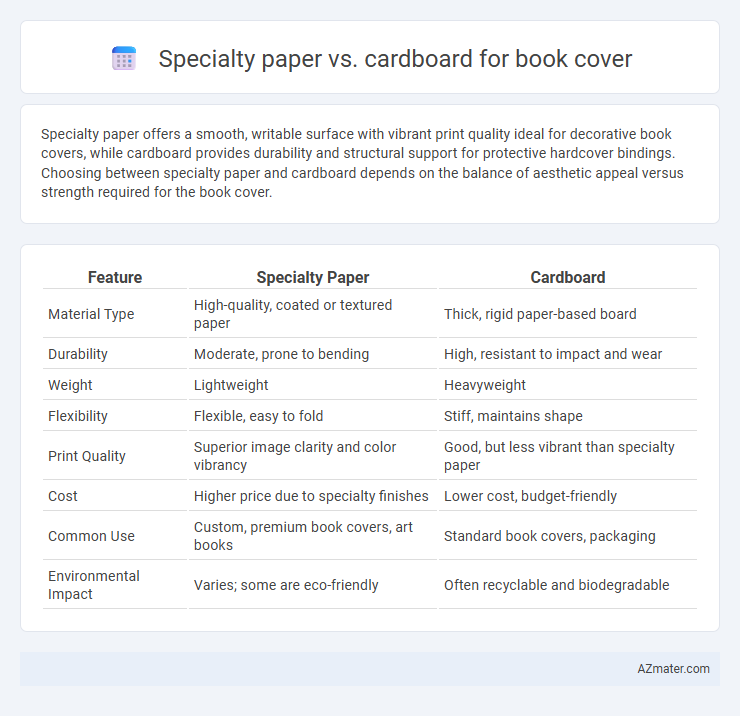Specialty paper offers a smooth, writable surface with vibrant print quality ideal for decorative book covers, while cardboard provides durability and structural support for protective hardcover bindings. Choosing between specialty paper and cardboard depends on the balance of aesthetic appeal versus strength required for the book cover.
Table of Comparison
| Feature | Specialty Paper | Cardboard |
|---|---|---|
| Material Type | High-quality, coated or textured paper | Thick, rigid paper-based board |
| Durability | Moderate, prone to bending | High, resistant to impact and wear |
| Weight | Lightweight | Heavyweight |
| Flexibility | Flexible, easy to fold | Stiff, maintains shape |
| Print Quality | Superior image clarity and color vibrancy | Good, but less vibrant than specialty paper |
| Cost | Higher price due to specialty finishes | Lower cost, budget-friendly |
| Common Use | Custom, premium book covers, art books | Standard book covers, packaging |
| Environmental Impact | Varies; some are eco-friendly | Often recyclable and biodegradable |
Introduction to Specialty Paper and Cardboard for Book Covers
Specialty paper for book covers offers unique textures, finishes, and durability tailored to enhance aesthetic appeal and tactile experience, often used in high-end or limited edition books. Cardboard, commonly utilized as the structural base for book covers, provides rigidity and protection, making it essential for hardcover designs. Combining specialty paper with cardboard achieves an optimal balance of visual richness and functional durability in book cover production.
Material Composition: Specialty Paper vs Cardboard
Specialty paper for book covers is typically made from high-quality fibers such as cotton or wood pulp, offering a smooth, fine texture with enhanced durability and tear resistance. Cardboard, on the other hand, consists of multiple layers of compressed paper pulp, providing a thicker and more rigid structure ideal for protecting hardcover books. While specialty paper focuses on aesthetic appeal and print clarity, cardboard emphasizes structural integrity and impact resistance, making both materials complementary in book cover design.
Durability and Longevity Comparison
Specialty paper offers a smooth finish and enhanced print quality but generally lacks the durability and longevity of cardboard, making it more prone to wear and tear over time. Cardboard, especially when coated or laminated, provides superior structural strength and resistance to bending, ensuring better protection for book covers during handling and storage. For long-lasting book covers, cardboard is preferred due to its robustness and ability to maintain shape under stress, whereas specialty paper is often used for aesthetic titles or dust jackets that require frequent replacement.
Aesthetic Appeal and Customization Options
Specialty paper offers a refined texture and a wide range of finishes, such as glossy, matte, and embossed, enhancing the aesthetic appeal of book covers with vibrant colors and intricate designs. Cardboard provides a sturdy base, allowing for durable covers that can be customized with various laminations, foil stamping, or die-cut shapes to create distinctive tactile experiences. Both materials support unique customization options, but specialty paper excels in detailed visual effects, while cardboard emphasizes structural versatility and protection.
Printing Quality and Design Flexibility
Specialty paper offers superior printing quality with vibrant colors and sharp details, making it ideal for intricate book cover designs requiring high-resolution imagery. Cardboard provides greater design flexibility through its sturdiness, enabling embossing, debossing, and foil stamping techniques that enhance tactile and visual appeal. While specialty paper excels in fine graphic reproduction, cardboard is preferred for durable, textured covers that support creative finishes and structural integrity.
Environmental Impact and Sustainability
Specialty paper used for book covers typically involves high-quality, often coated or treated fibers that can limit recyclability and increase environmental impact due to chemical processing. Cardboard, especially recycled or sustainably sourced varieties, offers greater environmental benefits through easier recyclability and biodegradability, supporting circular economy principles. Choosing cardboard with certifications such as FSC or SFI significantly enhances sustainability by ensuring responsible forest management and reduced carbon footprint.
Cost Considerations: Budgeting for Book Covers
Specialty paper for book covers often incurs higher costs due to its unique textures and finishes, whereas cardboard offers a more affordable, durable option for budget-conscious projects. The thickness and quality of cardboard provide ample protection at a lower price point, making it ideal for large print runs with tight cost constraints. Assessing print volume and desired aesthetic helps determine whether investing in specialty paper justifies the increased expenditure or if sturdy cardboard meets functional and financial requirements.
Tactile Experience and User Perception
Specialty paper offers a refined tactile experience with smooth textures and customizable finishes that enhance user perception of luxury and quality in book covers. Cardboard provides a sturdier, more substantial feel, often perceived as durable and protective but less sophisticated in touch. Choosing between the two depends on the desired balance between tactile elegance and robust functionality in book cover design.
Application Suitability: Genre and Market Trends
Specialty paper offers a versatile, smooth finish ideal for high-end fiction and art books, enhancing visual appeal and tactile experience, which aligns with premium market trends focusing on aesthetic quality. Cardboard provides durability and rigidity favored in textbooks and children's books, supporting frequent handling and longevity demanded by educational and mass-market genres. Market trends indicate an increasing preference for sustainable specialty papers in boutique publishing, while cardboard remains dominant in cost-sensitive, high-volume segments.
Final Recommendation: Choosing the Right Material
Specialty paper offers a smooth finish and vibrant print quality ideal for high-end, visually appealing book covers, while cardboard provides superior durability and protection, making it suitable for heavy-use or larger volumes. Selecting the right material depends on the book's purpose, expected handling, and aesthetic requirements; specialty paper excels in premium aesthetics, whereas cardboard ensures longevity and structural integrity. For collectible editions or art books, specialty paper is recommended; for textbooks or children's books, cardboard is the optimal choice.

Infographic: Specialty paper vs Cardboard for Book cover
 azmater.com
azmater.com